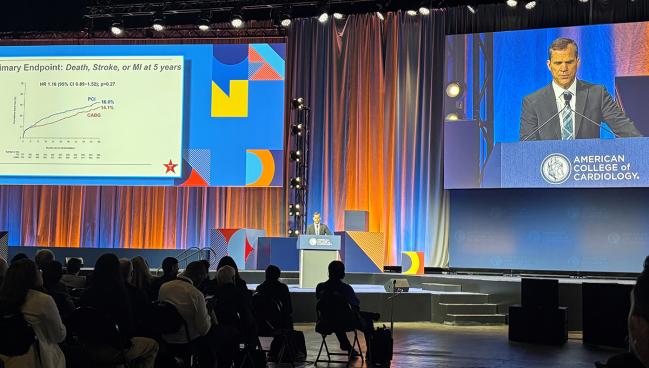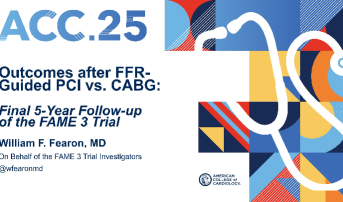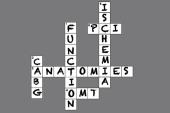PCI Rebounds at 5 Years to Mostly Match CABG: Final FAME 3 Data
Cotemporary DES paired with FFR guidance and modern medical therapy may be what narrowed the gap, William Fearon says.

CHICAGO, IL—Five years down the line, patients with three-vessel disease who underwent fractional flow reserve (FFR)-guided PCI have clinical outcomes on par with patients who were treated initially with CABG surgery, according to final follow-up from the FAME 3 trial.
There was no difference in the composite of death, stroke, or MI between the two groups, though MI and revascularization rates were higher for patients assigned to receive FFR-guided PCI.
The results stand in contrast to FAME 3’s main findings, wherein PCI failed to show noninferiority compared with CABG at 1 year for the composite of death, stroke, MI, or repeat revascularization. By 3 years, the prespecified secondary endpoint of death, stroke, or MI also was similar between the two study arms, with a trend favoring CABG.
William F. Fearon, MD (Stanford University, CA), lead investigator for FAME 3, shared the latest from the trial yesterday in a late-breaking clinical trial session at the American College of Cardiology (ACC) 2025 Scientific Session. The findings were simultaneously published in the Lancet.
Most evidence in the literature comparing PCI versus CABG in three-vessel disease is “outdated given improvements in percutaneous and surgical techniques, and in medical therapy,” said Fearon, who noted that “in older studies, the improved outcomes after CABG continued to increase with longer-term follow-up.
But FAME 3 involved both current-generation DES and contemporary PCI using FFR, as well as guideline-directed medical therapy, making it possible to see how outcomes have shifted as the field has evolved, he explained.
Akshay Khandelwal, MD (Allegheny Health Network, Pittsburgh, PA), commenting on FAME 3 in an ACC press conference, said the findings are signs of an evolution in care.
“Since the advent of angioplasty, the cardiovascular community has continued to wonder whether a less invasive but increasingly more effective procedure could approximate the more invasive but gold standard [of] CABG,” Khandelwal said.
These data “add to that conversation,” by showing “that when directed by objective physiological information on top of optimal medical therapy, in many cases PCI can approximate surgical results,” he said. At a minimum, added Khandelwal, this knowledge should prompt discussion among the patient, referring cardiologist, interventionalist, and surgeon about how best to proceed.
Final Follow-up
|
|
PCI |
CABG |
HR (95% CI) |
|
Death/Stroke/MI |
16% |
14% |
1.16 (0.89-1.52) |
|
Death |
7% |
7% |
0.99 (0.67-1.46) |
|
Stroke |
2% |
3% |
0.65 (0.33-1.28) |
|
MI |
8% |
5% |
1.57 (1.04-2.36) |
|
Repeat Revascularization |
16% |
8% |
2.02 (1.46-2.79) |
FAME 3, an investigator-initiated trial that took place at 48 centers across Europe, North America, Australia, and Asia, enrolled 1,500 patients with three-vessel disease, randomizing them to FFR-guided PCI (all lesions with FFR ≤ 0.80 were stented) or CABG (based on angiography).
At 5 years, full follow-up was available for 96% of patients assigned to PCI and 94% of those assigned to CABG. Medical therapy was similarly good in both groups, with around 90% on an antiplatelet, more than 91% on a statin, more than 70% on a beta-blocker, and more than 70% on an ACE inhibitor/ARB.
Fearon pointed out that the endpoint reported in this analysis—death, stroke, or MI—“was prespecified but not explicitly powered or adjusted for multiple comparisons.”
At 5 years, there was no difference in this composite, or in the individual endpoints of death or stroke, between PCI and CABG. However, PCI patients did experience significantly more MI and repeat revascularization.
FAME 3: Five-Year Follow-up
Additionally, a landmark analysis found that “after 1 year there was no late accrual of benefit with CABG,” Fearon told the ACC audience.
Patients with low SYNTAX scores of less than 23 obtained similar protection against death/stroke/MI regardless of study arm (HR 0.72; 95% CI 0.42−1.24), as did those with high SYNTAX scores above 32 (HR 0.83; 95% CI 0.43−1.60), though in both groups the trends favored PCI. However, those with intermediate scores fared worse with PCI (HR 1.64; 95% CI 1.11−2.43).
Fearon also presented a comparison between FAME 3 and the three-vessel disease cohort of the 2009 SYNTAX trial. The dissimilarities were “stark,” he said. In SYNTAX, the 5-year rate of death/stroke/MI was 22% with PCI—fully 6 percentage points higher than seen in the 5-year FAME 3 data. The rate of that endpoint for CABG in both trials was 14%. For death, the rate was nearly 15% with PCI in SYNTAX, twice as high as in FAME 3.
“The difference in outcomes at 5 years between PCI and CABG has narrowed likely due to improved stent technology, the routine application of FFR-guided PCI, and greater adherence to guideline-directed medical therapy,” Fearon said. This contemporary evidence, he added, “can facilitate improved shared decision-making between physicians and patients.”
To TCTMD, Fearon said that despite FFR being studied for so long and in so much depth, there’s still much to learn about physiological assessment.
“Coronary physiology has really grown and is playing an integral role in our cath lab procedures,” but more data are needed in acute coronary syndromes, especially in nonculprit vessels, he commented. It’s also important to look beyond FFR at other methods like coronary flow reserve and index of microcirculatory resistance for exploring microvascular dysfunction, as in the WARRIOR trial.
One sign of the “interest and excitement about physiology” is the fact that so many companies are exploring new, noninvasive methods derived from tools like angiography and computed tomography, said Fearon. “I think it’s here to stay and hopefully will continue to grow.
A Surgeon’s Perspective
Cardiac surgeon S. Chris Malaisrie, MD (Northwestern University Feinberg School of Medicine, Chicago, IL), who served as the discussant for FAME 3, said it captures shifts in care. “The FAME 3 trial continues the saga of what we need to do for patients with multivessel disease, in terms of type of revascularization. Specifically, what is the benefit of FFR-guided PCI?”
Malaisrie said what’s “striking” to him about FFR is that its use in PCI actually results in fewer stents being implanted. FAME 3 did not mandate FFR in the CABG arm, though, which raises the question of what the tool might have added. “I suspect if I saw FFR I’d probably ignore it as well and bypass everything I could for fear of incomplete revascularization,” he commented, asking if the trial offers any insights on how FFR could have guided CABG.
Fearon said that the FAME 3 investigators debated this possibility when designing the study, but since many referring centers didn’t do FFR at the time of angiography, this would mean some patients would’ve had to undergo an extra round of invasive angiography in the cath lab before randomization to CABG. “We did allow it, and in fact 10% of the population in the CABG group had FFR measured,” he explained. Earlier trials comparing FFR-guided versus angiography-guided CABG haven’t shown “dramatic benefits, so I don’t think the benefit of FFR applies as much to CABG as it does to PCI.”
Malaisrie also drew attention to the fact that, unlike in the 3- and 5-year analyses, the primary endpoint at 1 year included repeat revascularization. “It seemed like if you included repeat revascularization in the primary outcome, that CABG was better,” he noted, questioning why that endpoint was important enough to consider at 1 year but not thereafter.
In reply, Fearon said that they had at first wanted to align with the design of the SYNTAX trial, “so that way we could directly compare differences in outcomes.”
But even then, the researchers felt repeat revascularization, as an endpoint, was evolving. “It’s really more of a decision than an endpoint—the physician decides whether or not to do it,” he said, noting that the decision-making has changed as repeat PCI has, thanks to advancements like radial access, become less onerous for patients. Moreover, some studies have hinted at bias, with PCI patients facing greater scrutiny that sends them back to the cath lab more often than CABG patients. Thus, as time went on, the FAME 3 investigators put more emphasis on hard endpoints, Fearon said.
Caitlin E. Cox is News Editor of TCTMD and Associate Director, Editorial Content at the Cardiovascular Research Foundation. She produces the…
Read Full BioSources
Fearon WF, Zimmermann FM, Ding VY. Outcomes after fractional flow reserve-guided percutaneous coronary intervention versus coronary artery bypass grafting (FAME 3): 5-year follow-up of a multicentre, open-label, randomised trial. Lancet. 2025;Epub ahead of print.
Disclosures
- Fearon reports receiving research funding from Abbott, Medtronic, and CathWorks and having stock options from HeartFlow.






Comments